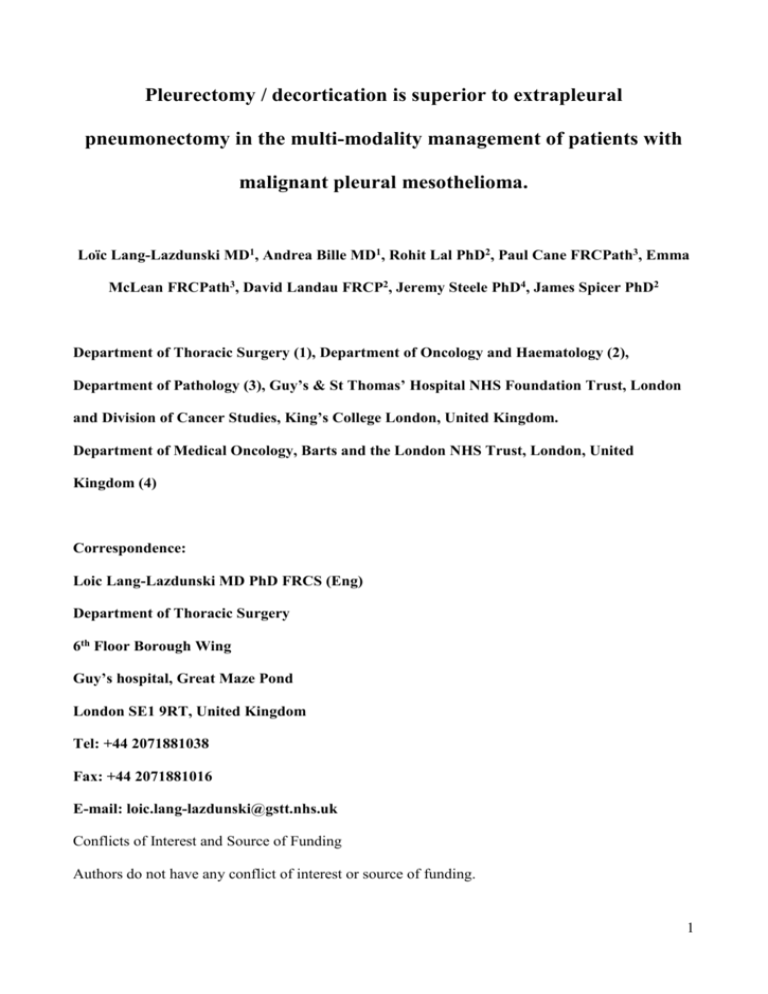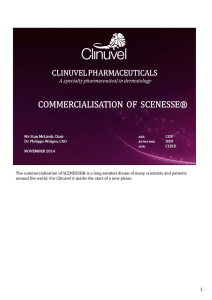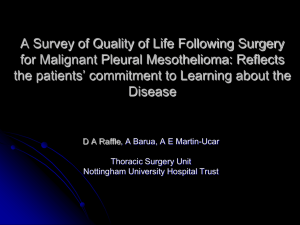Studies - Asbestos.com
advertisement

Pleurectomy / decortication is superior to extrapleural pneumonectomy in the multi-modality management of patients with malignant pleural mesothelioma. Loïc Lang-Lazdunski MD1, Andrea Bille MD1, Rohit Lal PhD2, Paul Cane FRCPath3, Emma McLean FRCPath3, David Landau FRCP2, Jeremy Steele PhD4, James Spicer PhD2 Department of Thoracic Surgery (1), Department of Oncology and Haematology (2), Department of Pathology (3), Guy’s & St Thomas’ Hospital NHS Foundation Trust, London and Division of Cancer Studies, King’s College London, United Kingdom. Department of Medical Oncology, Barts and the London NHS Trust, London, United Kingdom (4) Correspondence: Loic Lang-Lazdunski MD PhD FRCS (Eng) Department of Thoracic Surgery 6th Floor Borough Wing Guy’s hospital, Great Maze Pond London SE1 9RT, United Kingdom Tel: +44 2071881038 Fax: +44 2071881016 E-mail: loic.lang-lazdunski@gstt.nhs.uk Conflicts of Interest and Source of Funding Authors do not have any conflict of interest or source of funding. 1 ABSTRACT Introduction: To compare the outcomes of two different multi-modality regimens involving neoadjuvant chemotherapy, extrapleural pneumonectomy (EPP) and adjuvant radiotherapy versus pleurectomy/decortication (P/D), hyperthermic pleural lavage with povidone-iodine and adjuvant chemotherapy in patients with malignant pleural mesothelioma. Methods: Non-randomized prospective study of patients treated by multimodality therapy and operated on between January 2004 and June 2011. Second line treatments were administered when appropriate. Survival and prognostic factors were analysed by the Kaplan-Meier method, log-rank test and Cox regression analysis. Results: Twenty five consecutive patients received neoadjuvant chemotherapy, 22 underwent EPP and 17 received adjuvant radiotherapy. Over the same period, Fifty four consecutive patients underwent P/D and hyperthermic pleural lavage and received prophylactic radiotherapy and adjuvant chemotherapy. The thirty day mortality was 4.5% in the EPP group and nil in the P/D group. Fifteen patients (68%) experienced complications in the EPP group and fifteen (27.7%) in the P/D group. There were no differences between the EPP and P/D groups for age, sex , histology, pathologic stage and nodal status. Trimodality therapy was completed by 68% of patients in the EPP group and 100% % in the P/D group. Survival was significantly better in the P/D group: median survival 23 months versus 12.8 months, 2-year survival 49% versus 18.2 % and 5-year survival 30.1% versus 9%, respectively (p=0.004). At multivariate analysis epithelioid histology, pleurectomy/decortication and completeness of resection were independent prognostic factors. Conclusions: In our experience, pleurectomy/decortication, hyperthermic pleural lavage with povidone-iodine and adjuvant chemotherapy was superior to neoadjuvant chemotherapy, EPP and adjuvant radiotherapy. Key words: Malignant pleural mesothelioma, Pleurectomy, Extrapleural pneumonectomy. 2 Introduction Malignant pleural mesothelioma (MPM) remains a major cause of death in patients exposed to asbestos (1). At present, there is no known curative treatment for MPM and the majority of patients are offered palliative chemotherapy (2). Median survival following diagnosis is often less than 12 months (2, 3). However, patients with early stage disease and good performance status are suitable for multi-modality therapy involving surgery, radiotherapy and chemotherapy (4-5). Extrapleural pneumonectomy (EPP) gained wide acceptance following the publications of Sugarbaker and Rusch showing prolonged survival in patients with epithelioid histology (5, 6). Large experiences have now been accumulated at some institutions offering chemotherapy, extrapleural pneumonectomy and adjuvant radiotherapy, with 5-year survival rates over 40% in patients with favorable prognostic factors (7-9). Although EPP-related mortality is now less than 8% in large-volume centres, less than 60% of patients complete tri-modality treatment due to death or major complications (7-13). When patients relapse following EPP, they usually die within 3 months due to lack of further effective treatment options (14). Pleurectomy / decortication (P/D) has long been used in patients with MPM. In 1976, Martini and his group reported a median survival of 21 months following pleurectomy, adjuvant radiotherapy and systemic chemotherapy (15). More recently, similar outcomes have been reported in patients treated with P/D and adjuvant radiotherapy plus chemotherapy (16-18). Since 2004, we have offered EPP and P/D as part of our multimodality therapy program. Some patients were not suitable for EPP or refused to have EPP and we developed an alternative multimodality therapy regimen for these patients based on P/D and hyperthermic pleural lavage followed by prophylactic radiotherapy and adjuvant chemotherapy. This study aims at analyzing the outcomes of patients treated consecutively at our institution with those two different multi-modality regimens. 3 Patients and Methods Between January 2004 and June 2011, patients referred for multi-modality therapy were offered either neodjuvant chemotherapy, followed by EPP and adjuvant radiotherapy (54 Gy) or P/D and hyperthermic pleural lavage with povidone-iodine followed by prophylactic radiotherapy (21 Gy in 3 fractions) at 4-6 weeks and adjuvant chemotherapy started at 6-8 weeks postoperatively. Recruitment was via a specialized multi-disciplinary thoracic oncology clinic involving thoracic surgeons, radiation oncologists and medical oncologists. Histopathology and imaging review was undertaken for all patients. The choice of multi-modality regimen was determined by patient’s performance status, co-morbidities, clinical TNM stage, histologic subtype and patient’s preference. Patients not wishing to undergo EPP or to enrol into a trial offering EPP (19) were offered the alternative treatment involving P/D and pleural lavage, prophylactic radiotherapy and adjuvant chemotherapy. All surgical procedures in this study were performed by the same surgeon (LLL). All patients had 18 fluoro-deoxyglucose-positon-emission tomography-computed tomography (PET-CT) performed preoperatively to exclude N3 disease or extra-thoracic metastases. Previous talc pleurodesis was not regarded as a contra-indication to the performance of EPP or P/D. Mediastinoscopy was offered to all patients scheduled to have EPP to rule out N2 disease, as this was regarded as a contra-indication to EPP in our centre. However, non-bulky N2 disease was not regarded as a contra-indication to P/D and mediastinoscopy was not routinely performed before P/D. Only patients with performance status 0-1 were offered multi-modality therapy at our institution. This was a non-randomized study. The primary endpoint was survival. Secondary endpoints included mortality and treatment-related complications. Neoadjuvant chemotherapy protocol (EPP group) All patients received neoadjuvant chemotherapy before EPP. Eleven patients received 3 cycles of induction chemotherapy with cisplatin (80 mg/m2) and gemcitabine (1000mg/m2). Fourteen patients 4 received 3 cycles of induction chemotherapy with cisplatin (80mg/m2) and pemetrexed (500mg/m2). Repeat imaging showed potentially resectable disease in all patients. Surgical protocol for EPP and P/D groups Extrapleural pneumonectomy involved en-bloc resection of the affected lung, visceral and parietal pleurae, ipsilateral pericardium, anterior mediastinal fat and diaphragm. All procedures were performed through a large posterolateral thoracotomy (5th and 8th interspace). Pericardium was replaced with a Polyglactin mesh (Vicryl, Ethicon, Johnson & Johnson Intl, St Stevens Woluwe, Belgium) and diaphragm was replaced with a Gore Tex mesh (2-mm Dual Mesh, WL Gore and associates UK Ltd, Livingston, West Lothian, UK) in all patients. Systematic dissection of the mediastinal and internal mammary lymph nodes was routinely performed. All patients were staged according to the IMIG staging system. The goal in all patients undergoing P/D was to achieve maximal cytoreduction and a complete macroscopic resection. The approach was always a posterolateral thoracotomy through the 5th intercostal space. Occasionally, a second access thoracotomy was made in the 8th interspace to help achieve complete resection of tumor in the diaphragmatic recess or to resect the diaphragm. Extended resection to include the pericardium, lung, or diaphragm was undertaken as necessary. When the diaphragm was involved (deep muscular invasion) it was resected and reconstructed using a large Gore Tex mesh. Following extrapleural dissection, complete decortication of the lung was performed including the pulmonary fissures down to the pulmonary hilum and pleural reflection. Lymphadenectomy of the internal mammary chains and mediastinal chains was routinely performed. Once the P/D had been completed, we performed a hyperthermic pleural lavage (40-41˚C) using sterile water mixed with 10% povidone-iodine (Videne, Ecolab. Ltd, Lotherton Way Gartforth, Leeds, UK, dilution 1/10). In all patients 5-6 L of water were used. The washout was allowed to 5 bath in the pleural cavity for 5 minutes while the lung was being ventilated and was then aspirated. This manoeuvre was repeated three times (total 15 min). Adjuvant radiotherapy post-EPP The prescribed dose was 54Gy in 30 fractions over 6 weeks to the 100% isodose. For right-sided patients it was not always possible to safely prescribe 54Gy to the lower half of the field due to dose constraints to the liver. The minimum prescribed dose to the lower portion of right-sided volumes was 45Gy. Radiotherapy was administered using a 6MV linear accelerator and a three dimensional, conformal technique with multi-leaf collimation. Prophylactic radiotherapy protocol post P/D All patients were reviewed in clinic at 4-5 weeks postoperatively and referred for prophylactic radiotherapy (21 Gy in 3 daily fractions) on the thoracotomy, drain and previous port sites according to Boutin’s protocol (20). Adjuvant chemotherapy protocol post P/D Adjuvant chemotherapy was started 6-8 weeks and consisted in a combination of gemcitabine (1000 mg/m2) and cisplatin (80 mg/m2) before 2007 (n=4), Pemetrexed (500 mg/m2) and Cisplatin (80 mg/m2) thereafter (n=50).The intent was to administer 4-6 cycles of chemotherapy. Patients were followed-up in the clinic regularly and had PET-CT arranged 6 monthly to monitor response to treatment or diagnose disease progression. Those relapsing following multimodality therapy were offered second line treament: combination chemotherapy with pemetrexed and cisplatin, single agent vinorelbine, or single agent Sorafenib as part of a phase I trial. 6 Statistical analysis Continuous data are reported with medians and ranges, while categorical data are reported with counts and percentages. All potential prognostic indices were measured at the time of operation and evaluated as categorical variables. Survival was expressed from diagnosis. Survival and prognostic factors were analysed by the Kaplan-Meier method, log-rank test and Cox proportional hazards regression analysis. HRs and 95 CIs were used to quantify the observed differences. Probability values less than 0.05 were considered statistically significant. All analyses were conducted using the SPSS (SPSS Inc., Chicago, IL, USA) software package. Results EPP group Twenty five patients consented to have EPP. In 3 patients EPP was abandoned due to extent of disease at the time of surgery (T4 including aortic invasion in two patients and multi-focal chest wall invasion in one patient). Eleven procedures were left-sided and 11 right-sided. One patient died of aortic rupture intra-operatively making our 30-day mortality rate 4.5%. Complications were experienced by 68% of patients after EPP and are reported in table 2. Median postoperative inhospital stay was 14 + 10 days (range 8 to 60). All three patients who suffered a bronchopleural fistula and empyema had open window thoracostomy performed 9 to 28 weeks following EPP. Two of these patients did not receive adjuvant radiotherapy. One patient had received adjuvant radiotherapy before suffering pleural empyema. Seventeen patients (68%) received adjuvant radiotherapy and completed the full multi-modality treatment. Radiotherapy was started 8 to 12 weeks after EPP. Five patients did not receive radiotherapy because one died intraoperatively, two presented a bronchopleural fistula with empyema, one progressed before having radiotherapy developing controlateral pulmonary 7 metastases and one developed a late septicemia 2 months after surgery. One patient with bronchopleural fistula and empyema is still alive, he underwent an open window thoracostomy followed by reconstruction one year later. Survival for these 5 patients was: 0, 2, 31, 2.9 and 55 months (mean 14.6 and median 2.9 months). Complications of radiotherapy included: grade 1 esophagitis (n=6, 35.3%), radiation hepatitis (n=3, 17.6%), radiation pneumonitis (n=2, 11.8%), fatal pulmonary embolus (n=1, 5.9%), fatal pneumonia (n=1, 5.9%), grade 3 thombocytopenia (n=1, 5.9%), Herpes Zoster transverse myelitis (n=1, 5.9%), late constrictive pericarditis (n=1, 5.9%). In EPP patients, death was mainly related to disease progression (n=17, 81%) with patients diagnosed with intra-thoracic relapse (52%), peritoneal relapse (40%) or relapse at distant sites (16%). Some patients had relapse in multiple sites. The median follow up of 22 patients who underwent EPP was 12.9 months (0-55). Five patients were followed up for more than two years Two patients are still alive 55 and 51 months postoperatively. Twenty patients have died at the time of the analysis (October 2011). P/D group Sixty one patients had P/D performed. Three mesothelioma patients referred for empyema and trapped lung following talc pleurodesis were excluded retrospectively due to the potential impact of empyema on the natural history of malignant mesothelioma. They did not undergo P/D with a curative intent. Chemotherapy was not administered to these patients. Three other patients were excluded as they had received intra-pleural gene therapy prior to P/D as part of a phase I trial at another centre. A total of 54 patients had P/D followed by prophylactic radiotherapy and adjuvant chemotherapy. Thirty three procedures were right-sided, 21 left-sided. Thirty one patients (57.4 %) underwent macroscopic complete resection whilst 23 underwent R2 resection (42.6 %). Extended resections 8 included diaphragm (n=5), lobectomy (n=3), segmentectomy (n=2) and pericardectomy (n=2). The 30-day mortality was nil. Fifteen patients (27.7%) experienced postoperative complications after P/D, all reported in table 2. We did not observe wound infections, pleural empyema or mesh infection in this series. Fifty two patients (96.3 %) received the planned 4-6 cycles of adjuvant chemotherapy and completed the full multimodality therapy regimen. Two patients received 2 cycles of adjuvant chemotherapy only together with prophylactic radiotherapy, due to poor tolerance of treatment. Fifteen patients received second line treatment or are receiving second line treatment at last followup. Second line treatment included pemetrexed and cisplatin (n=3), single-agent vinorelbine (n=7) or single agent sorafenib as part of a phase I trial (n=5). One patient diagnosed with very focal relapse at one year following P/D was treated with cyberknife radiosurgery and remains diseasefree at 51 months. Of note, none of our patients was diagnosed with chest wall tumor seeding at follow up. At the time of analysis, 28 of 54 patients were alive and 26 patients had died of disease progression. Survival is presented in figures 1-3. The median follow up of patients who underwent P/D was 15.7 (5-67.5) and 15 patients had a follow up of 2 years or more. The median interval between diagnosis and start of neoadjuvant treatment in EPP group was 4 months and the median interval between diagnosis and P/D was 3 months. Most patients underwent VATS and talc pleurodesis before P/D. Table 1 presents patients’ characteristics and shows there was no significant difference between the two groups of patients in terms of age, sex, histology, nodal status, TNM stage. There was no patient older than 70 years in the EPP group, whereas 9 out of 54 patients were older than 70 in the P/D group (p=0.04). 9 There was a statistically significant difference in survival between patients having EPP and those having P/D, in favor of P/D (p=0.004): median survival was 23 months versus 12.8 months , 1-year survival was 81.9% versus 54.5%, 2-year survival 49% versus 18.2% and 5-year survival 30.1% versus 9%, respectively. When comparing by histology, we found that patients with epithelioid tumor had a longer survival with P/D than with EPP (p=0.018): median survival 28.9 months versus 12.8 months , 1-year survival 91.2% versus 57.1%, 2-year survival 54% versus 28.6% and 5-year survival 42% versus 14.3%, respectively. Patients with non-epithelioid histology had a marginally better survival after P/D than after EPP (p=0.07): median survival 18.3 months versus 8.8 months, 1-year survival 62.3% versus 50%, 2-year survival 38% versus 0% and 5-year survival 9.5% versus 0%. Complete macroscopic resection was associated with longer survival in patients having P/D (p=0.02): median survival 31 months versus 16.6 months, 1-year survival 89% versus 72.7%, 2year survival 63.8% versus 28.5% and 5-year survival 38.7% versus 19%. Patients having P/D and complete macroscopic resection had a significantly longer survival than patients having EPP (p=0.0007): median survival 31 months versus 12.8 months, 1-year survival 89% versus 54.5%, 2year survival 63.8% versus 18.2% and 5-year survival 38.7% versus 9%, respectively. P/D provided a significant survival advantage over EPP in patients with N0 disease (p=0.04): median survival 28.9 months versus 12.9 months, 1 year survival 73% versus 60%, 2-year survival 54.8 % versus 10% and 5-year survival 18.3% versus 0%, respectively. However, the difference did not reach statistical significance in patients with N1-N2 disease (p=0.07): median survival 23.4 months versus 8.8 months, 1-year survival 85.6% versus 50%, 2-year survival 47.2% versus 25% and 5-year survival 33.8% versus 16.6%, respectively. When comparing by stage, we found that patients with early-stage disease (stage I and II) and patients with advanced-stage disease (III and IV) had a significantly longer survival in the P/D group than in the EPP group (p=0.004 and p=0.048, respectively). 10 Multivariate analysis showed that the type of surgical procedure (P/D versus EPP), histology and complete macroscopic resection were independent prognostic factors (table 3). Discussion The role of radical surgery -especially EPP- in MPM remains controversial (11). Retrospective series and recent phase II trials showed median survivals of 10-29 months following EPP in highly selected patients demonstrating favorable prognostic factors (5-10). In most series, the information was acquired retrospectively and data were not collected by “intention to treat”. Of note, in two recent prospective trials, less than 70% of patients could complete the full multi-modality treatment (7, 21). Although mortality has fallen consistently over time from 33% in 1976 to less than 8% now at most specialist centres (8-10, 12, 19), the morbidity associated with EPP remains high with serious complications developing in more than 50% of patients (12, 22). Adjuvant radiotherapy can generate significant complications and mortality as well (13). Recently, the results of the randomised mesothelioma and radical surgery (MARS) feasibility trial have been published and suggest that EPP offers no survival benefit and possibly harms patients (19). However, data were acquired in a limited number of patients and the trial was not powered to assess the superiority of EPP over no EPP (19). Recent studies suggest that P/D is an interesting option in patients with malignant pleural mesothelioma and early stage disease (18, 23-24). Mortality is low and complications are less common than following EPP (23). In a recent analysis of 663 patients operated on at 3 different institutions over a 16-year period, Flores et al. found that P/D was associated with a significantly better survival than EPP (23). However, the reasons were probably multi-factorial and subject to selection bias. Indications, surgical technique and perioperative management did probably vary over time and were possibly different at different institutions. Moreover, the use of adjuvant radiotherapy 11 and chemotherapy varied over the time period considered. Altogether, the level of evidence provided in this study is weak. In this setting, it seemed interesting to look at our recent personal experience with two different multimodality regimens involving EPP or P/D. The advantage of doing so is that the surgical cohorts are very homogeneous. Thus, all surgical procedures performed by the same thoracic surgeon, in the same hospital. We used similar radiotherapy and chemotherapy protocols in all patients. Our patient did not receive radical radiotherapy after P/D, but only prophylactic radiotherapy to avoid the risk of radiation pneumonitis (17). There is no evidence that radiotherapy > 45 Gy improves local control or survival after P/D. On the other hand, there is some evidence that radical radiotherapy after EPP improves local control (5-9), therefore our patients received radical radiotherapy after EPP. Chemotherapy regimens differ between the EPP and P/D groups. As others we have administered chemotherapy as a neoadjuvant treatment before EPP (7). On the other hand, it made more sense to administer chemotherapy as an adjuvant treatment after P/D to clearany residual microscopic or macroscopic disease. We recognize that the number of chemotherapy cycles received (3 versus 4-6) could have influenced survival in responding patients. All patients had been recruited through the same clinic and discussed by the same group of thoracic specialists using the same staging methods and selection criteria, entered prospectively into our mesothelioma database. As any single institution series, ours suffers limitations compared to a large multicentre study, even though all patients were selected by the same multidisciplinary team and were operated by the same surgeon reducing possible selection and treatment bias Our analysis shows that the EPP and P/D groups could be matched for age, sex, histology, TNM stage and nodal status. Although patients were not randomised for EPP or P/D, the analysis of 12 outcomes should provide some form of evidence regarding the superiority of one multi-modality regime over the other. At multivariate analysis, P/D, epithelioid histology and complete resection were independent prognostic factors, whereas TNM staging and nodal status were not. This is probably related to the small number of patients in the study. Larger series have previously showed the impact of stage and nodal disease on survival (5, 9). Our mortality rate for EPP (4.5%) and complications rate are comparable to those obtained at largevolume institutions (21). Our mortality rate for P/D (nil) and complications rate compare favourably to those obtained at other large-volume institutions (16-18). Therefore, we cannot be criticised for offering suboptimal surgery, a criticism made to the MARS trialists (25). The vast majority of our patients completed tri-modality therapy reflecting the good acceptance and tolerability of our multimodality regimens. Our goal, when performing EPP or P/D was always to achieve complete macroscopic resection (R0R1). Despite our efforts, this was not always possible and in some patients having P/D, we decided to accept an incomplete resection (R2) rather than perform EPP. Interestingly, in our experience patients having incomplete macroscopic resection with P/D (R2) had a survival similar to those having macroscopic complete resection with EPP. Survival rates were significantly better in patients having P/D and complete macroscopic resection (figure 3). Therefore, we suggest to perform maximal cytoreduction, but to spare the diaphragm (and pericardium) in order to minimize intraperitoneal seeding (intra-pericardial seeding) in patients who cannot have R0/R1 resection. We do not believe that EPP adds any survival advantage in this group of patients. The patterns of relapse following P/D have been well described by others and were similar in our series (14). Most patients relapsed in the ipsilateral hemithorax, progressed in the mediastinum, contralateral hemithorax and even developed systemic metastases. Of note, when patients had disease progression after P/D, most of them were still able to receive second-line chemotherapy or 13 targeted therapy as opposed to patients having had EPP who were often too unwell to receive any active treatment. In our experience, peritoneal seeding was exceptionally seen after P/D as opposed to EPP. Lastly, patients who develop pneumonia or pulmonary embolus following EPP are very likely to die, whereas they are more likely to survive if this happens after P/D. Although not often raised, this issue should always be considered in patients receiving multi-modality therapy for pleural mesothelioma (26). Considering that EPP resulted in higher mortality and morbidity than P/D, that P/D resulted in significantly better survival in our experience as in others, we propose that P/D becomes the standard surgical procedure offered as part of multi-modality therapy in malignant pleural mesothelioma. This has been our position since 2008 and others have shared the same opinion for several years (24, 27). As a randomised trial of EPP versus P/D is unlikely to be performed ever (28), we support the idea of a large multi-centre randomized trial of multimodality therapy involving P/D versus no P/D in patients with malignant pleural mesothelioma. The way surgeons perform P/D needs to be standardized first and in a second time a randomized study could evaluate the impact of P/D versus no P/D on survival and quality of life. 14 References 1. Peto J, Decarli A, La Vecchia C, Levi F, Negri E. The European mesothelioma epidemic. Br J Cancer 1999; 79: 666-72 2. Muers MF, Stevens RJ, Fisher P et al. Active symptom control with or without chemotherapy in the treatment of patients with malignant pleural mesothelioma (MS01): a multicentre randomised trial. Lancet 2008; 371:1685-1694 3. Vogelzang NJ, Rusthoven JJ, Symanowski J, et al. Phase III study of pemetrexed in combination with cisplatin versus cisplatin alone in patients with malignant pleural mesothelioma. J Clin Oncol 2003; 21: 2636-44 4. Maziak DE, Gagliardi A, Haynes AE, Mackay JA, Evans WK. Surgical management of malignant pleural mesothelioma: a systematic review and evidence summary. Lung Cancer 2005; 48: 157-69 5. Sugarbaker DJ, Flores RM, Jacklitsch M, et al. Resection margins, extrapleural nodal status and cell type determine postoperative long-term survival in trimodality therapy of malignant pleural mesothelioma : results in 183 patients. J Thorac Cardiovasc Surg 1999; 117:54-63 6. Rusch VW, Piantadosi S, Holmes EC. The role of extrapleural pneumonectomy in malignant pleural mesothelioma. A Lung Cancer Study Group trial. J Thorac Cardiovasc Surg 1991;102: 1-9 15 7. Krug LM, Pass HI, Rusch VW, et al. Multicenter phase II trial of neoadjuvant pemetrexed plus cisplatin followed by extrapleural pneumonectomy and radiation for malignant pleural mesothelioma. J Clin Oncol 2009; 27: 3007-13 8. Weder W, Stahel RA, Bernhard J, et al. Multicenter trial of neoadjuvant chemotherapy followed by extrapleural pneumonectomy in malignant pleural mesothelioma. Ann Oncol 2007; 18: 1196-202 9. De Perrot M, Feld R, Cho BC, et al. Trimodality therapy with induction chemotherapy followed by extrapleural pneumonectomy and adjuvant high-dose hemithoracic radiation for malignant pleural mesothelioma. J Clin Oncol 2009; 27: 1413-8 10. Rice D, stevens CW, Correa AM, et al. Outcomes after extrapleural pneumonectomy and intensity-modulated radiation therapy for malignant pleural mesothelioma. Ann Thorac Surg 2007; 84: 1685-92 11. Treasure T, Waller D, Tan C et al. The Mesothelioma and Radical Surgery Randomized Controlled Trial: The MARS Feasibility Study. J Thorac Oncol. 2009; 10: 1254-8 12. Sugarbaker DJ, Jaklitsch MT, Bueno R, et al. Prevention, early detection and management of complications after 328 consecutive extrapleural pneumonectomies. J Thorac Cardiovasc Surg 2004; 128: 138-46 13. Allen AM, Czerminska M, Janne P, et al. Fatal pneumonitis associated with intensity-modulated radiation therapy for mesothelioma. Int J Radiat Oncol Biol Phys 2006; 65: 640-5 16 14. Janne PA, Baldini EH. Patterns of failure following surgical resection for malignant pleural mesothelioma. Thorac Surg Clin 2004; 14: 567-73 15. Wanebo HJ, Martini N, Melamed MR, Hilaris B, Beattie EJJr. Pleural mesothelioma. Cancer 1976; 38: 2481-8 16. Neragi-Miandoab S, Richards WG, Sugarbaker DJ. Morbidity, mortality, mean survival and the impact of histology on survival after pleurectomy in 64 patients with malignant pleural mesothelioma. Int J Surg 2008; 6: 293-7 17. Lee TT, Everett DL, Shu HK, et al. Radical pleurectomy/decortication and intraoperative radiotherapy followed by conformal radiation with or without chemotherapy for malignant pleural mesothelioma. J Thorac Cardiovasc Surg 2002; 124: 1183-9 18. Bolukbas S, Manegold C, Eberlein M, Bergmann T, Fisseler-Eckhoff A, Schirren J. Survival after trimodality therapy for malignant pleural mesothelioma: radical pleurectomy, chemotherapy with cisplatin / pemetrexed and radiotherapy. Lung Cancer 2011; 71: 75-81 19. Treasure Tom, Lang-Lazdunski Loïc, Waller David, Bliss Judith, Tan, carol, Entwisle James, Snee Michael, O’Brien Mary, Thomas Gill, Senan Suresh, O’Byrne Ken, Kilburn Lucy, Spicer James, Landau David, Edwards John, Coomes Gill, Darlison Liz, Peto Julian on behalf of the MARS trialists. The Mesothelioma and Radical Surgery (MARS) randomized controlled trial comparing extra-pleural pneumonectomy (EPP) with no EPP in patients with malignant pleural mesothelioma. Lancet Oncol 2011; 12: 763-72 17 20. Boutin C, Rey F, Viallat JR. Prevention of malignant seeding after invasive diagnostic procedures in patients with pleural mesothelioma. Chest 1995; 108: 754–758 21. Van Schil PE, Baas P, Gaafar R, et al. Trimodality therapy for malignant pleural mesothelioma: results from an EORTC phase II multicentre trial. Eur Respir J 2010; 36: 1362-9 22. Cao C, Yan TD, Bannon PG, McCaughan BC. A systematic review of extrapleural pneumonectomy for malignant pleural mesothelioma. J Thorac Oncol 2010; 5: 1692-1703 23. Flores, Pass HI, Seshan VE, et al. Extrapleural pneumonectomy versus pleurectomy / decortication in the surgical management of malignant pleural mesothelioma: results in 663 patients. J Thorac Cardiovasc Surg 2008; 135: 620-6 24. Nakas A, Trousse DS, Martin-Ucar AE, Waller DA. Open lung-sparing surgery for malignant pleural mesothelioma: the benefits of a radical approach within multimodality therapy. Eur J Cardiothorac Surg 2008; 34: 886-91 25. Weder W, Stahel R, Baas P, et al. The MARS feasibility trial: conclusions not supported by data. Lancet Oncol 2011; 12: 1093-14 26. Patel A, Anraku M, Darling GE, et al. Venous thromboembolism in patients receiving multimodality therapy for thoracic malignancies. J Thorac Cardiovasc Surg. 2009; 138: 843-8. 18 27. Cameron RB. Extrapleural pneumonectomy is the preferred surgical management in the multimodality therapy of pleural mesothelioma: con argument. Ann Surg Oncol 2007; 14:1249-53 28. Rusch VW. The MARS trial: resolution of the surgical controversies in mesothelioma? J Thorac Oncol 2009; 4: 1189-91 19 Figures Figure 1. Overall survival following EPP versus P/D. Figure 2. Overall survival following EPP versus P/D in patients with epithelioid histology. Figure 3. Impact of complete macroscopic resection on survival. There is no statistical difference in terms of survival between incomplete macroscopic resection in P/D patients and in complete macroscopic resection in EPP patients (p=0.2). 20









